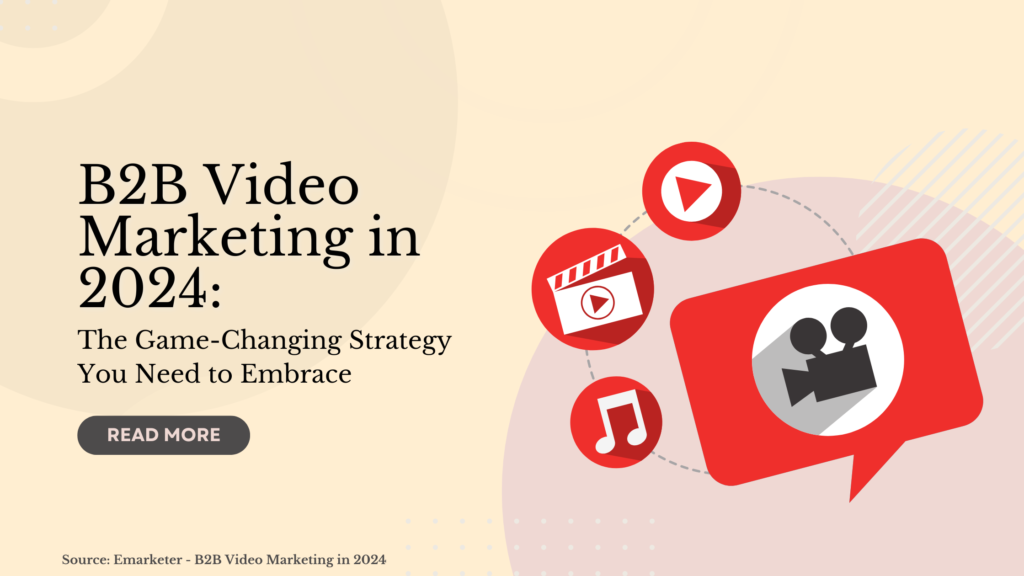At MKI Marketing, we recognize that video has firmly established itself as the most powerful content type in B2B marketing for 2024. Whether through short-form clips on social media or detailed educational videos, video is driving engagement, building trust, and influencing buying decisions like never before. Here’s why video marketing is essential and how you can harness its power to enhance your B2B strategy.
Table of Contents
ToggleThe Rise of Video in B2B Marketing
Video is now the star player in B2B content marketing, offering unparalleled versatility. As highlighted by eMarketer, video is proving to be the most effective medium for engaging audiences, whether through email campaigns, social media posts, or embedded on websites. An April 2024 survey by 10Fold reveals that 41% of B2B marketers plan to increase their video content distribution in 2024, making it a top priority just behind social media content.

This surge in video adoption is driven by evolving audience preferences, especially on platforms like LinkedIn and YouTube, where short-form and user-generated content (UGC) are highly favored. Video enables companies to humanize their brands, forge emotional connections, and enhance recognition—critical elements for B2B success.
For more insights into how video marketing can elevate your capital fund strategy, check out our blog post on Video Marketing for Capital Funds: What You Need to Know.
The Power Duo: Social Media and Video
Combining video with social media platforms is one of the most effective strategies for B2B marketing in 2024. Short-form videos, in particular, perform exceptionally well thanks to evolving algorithms that favor this content type. Platforms such as TikTok, Instagram, LinkedIn, and YouTube are crucial for distributing video content, with short-form videos often delivering the highest return on investment (ROI).
Social media video content is not only vital for reaching current decision-makers but also for engaging the next generation of B2B buyers—Gen Z. This demographic, rapidly entering B2B buying committees, prefers short, engaging videos to inform their purchasing decisions.
LinkedIn and YouTube: The Top Platforms for B2B Video
In the B2B realm, LinkedIn and YouTube are the go-to platforms for video marketing. LinkedIn stands out as a leading platform for video ads, interviews, and UGC. According to eMarketer, LinkedIn video uploads are projected to increase by 45% year-over-year, making it a key channel for B2B marketers. The platform’s introduction of Connected TV (CTV) ads and Thought Leader Ads further enhances its effectiveness for reaching target audiences.
YouTube excels in providing long-form and educational content, offering a valuable space for in-depth information that B2B buyers seek during their decision-making process. As B2B video advertising spending rises, YouTube remains a critical tool for driving traffic, improving searchability, and educating potential clients.

AI’s Role in Video Production and Personalization
With the growing demand for video, AI is transforming video marketing by enhancing production efficiency and personalizing content. AI tools streamline tasks such as editing, captioning, and creating personalized content for specific audience segments. While only 18% of marketers currently use AI for video production, a March 2024 Wistia report shows that 66% are eager to incorporate AI tools into their video strategies in the coming year.
Despite these advancements, there’s still room for improvement in AI-driven content quality. For now, AI is best suited for enhancing efficiency rather than replacing creative professionals. Innovations in video editing and content recommendations are expected to further advance AI’s role in marketing.
Challenges and Solutions in Measuring Video Success
Measuring the success of video campaigns presents challenges for B2B marketers. Tracking viewer engagement and ROI can be difficult, with tools like Wistia and YouTube providing some solutions. Budget constraints also limit video production capabilities, with many marketers spending less than $10,000 annually on video content. AI tools can help create high-quality content on a budget by automating time-consuming tasks and expanding the capabilities of small teams.
For strategies to improve video engagement and ROI, explore our blog on Navigating the Future of B2B Social Media Marketing
Strategic Storytelling and Audience Insights
In a competitive market, bold storytelling through video can set your brand apart. It’s crucial to understand your audience’s behaviors and preferences to create content that engages and converts. Utilizing diverse video formats—from high-production pieces to more casual recordings—can cater to various stages of the buyer’s journey. Leveraging first-party data to measure video engagement helps refine strategies and improve ROI.
Conclusion: Video is the Future of B2B Marketing
As we advance through 2024, video will continue to play a pivotal role in B2B marketing. By combining the power of video with social media, optimizing platforms like LinkedIn and YouTube, and utilizing AI for production and personalization, B2B marketers can maximize their impact and drive results. With a focus on storytelling and audience insights, video will remain a crucial tool for engaging today’s buyers and the next generation.
Ready to take your B2B marketing to the next level with video? Contact MKI Marketing to discover how we can help you leverage video for maximum impact.


